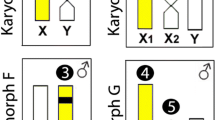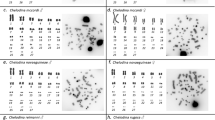Abstract
Hoplias malabaricus, a widely distributed neotropical fish (Central America to Argentina), may represent a group of distinct species showing diversified cytotypes with respect to chromosome number, morphology and sex systems. One of these karyotypic forms is characterized by an X1X1X2X2/X1X2Y sex chromosome system, with 2n= 40 and 39 chromosomes in females and males respectively. Analyses with G-, C- and chromosome replication banding permitted a better characterization of the sex chromosomes in this cytotype. The Y chromosome, unique in males, resulted from a translocation event between two biarmed chromosomes: one similar to chromosome 6 (X1) and the other one similar to chromosome 20 (X2), the latter corresponding to a probable identification. On the basis of the observed banding patterns, the Y chromosome may represent a stable dicentric, with an inactive centromere interstitially located on its long arm. The results are also related to a specific satellite DNA subfamily, previously characterized in Hoplias malabaricus, which appears to be associated with the X1 chromosome.
Similar content being viewed by others
References
Abuín M, Martínez P, Sánches L (1996) G-like banding pattern in two salmonid species: Oncorhynchus mykiss and Oncorhynchus kisutch. Chrom Res 4: 471–473.
Almeida-Toledo LF, Foresti F, Toledo-Filho SA (1984) Complex sex chromosome system in Eigenmannia sp (Pisces, Gymnotiformes). Genetica 64: 165–169.
Almeida-Toledo LF, Viegas-Péquinot E, Foresti F, Toledo-Filho SA, Dutrillaux B (1988) BrdU replication patterns demonstrating chromosome homeologies in two fish species, genus Eigenmannia. Cytogenet Cell Genet 48: 117–120.
Amores A, Bejar J, Alvarez MC (1995) BrdU replication bands in the anguilliform fish Echelus myrus. Chrom Res 3: 423–426.
Bertollo LAC (1996) The nucleolar organizer regions of Erythrinidae fish. An uncommon situation in the genus Hoplias. Cytologia 61: 75–81.
Bertollo LAC, Takahashi CS, Moreira-Filho O (1979) Karyotypic studies of two allopatric populations of the genus Hoplias (Pisces, Erythrinidae). Brazil J Genet 2: 17–37.
Bertollo LAC, Takahashi CS, Moreira-Filho O (1983) Multiple sex chromosomes in the genus Hoplias (Pisces, Erythrinidae). Cytologia 48: 1–12.
Bertollo LAC, Moreira-Filho O, Galetti Jr PM (1986) Cytogenetics and taxonomy: considerations based on chromosome studies of freshwater fish. J Fish Biol 28: 153–159.
Bertollo LAC, Moreira-Filho O, Fontes MS (1997) Karyotypic diversity and distribution in Hoplias malabaricus (Pisces, Erythrinidae). Cytotypes with 2n. 40 chromosomes. Brazil J Genet 20: 237–242.
Brum MJI, Galetti Jr PM, Corrêa MMO, Aguilar CT (1992) Multiple sex chromosomes in South Atlantic fish, Brevoortia aurea, Clupeidae. Brazil J Genet 15: 547–553.
Dergam JA, Bertollo LAC (1990) Karyotypic diversification in Hoplias malabaricus (Osteichthyes, Erythrinidae) of the São Francisco and Alto Paraná basins, Brazil. Brazil J Genet 13: 755–766.
Drouin R, Holmquist GP, Richer CL (1994) High resolution replication bands compared with morphologic C-and R-bands. In: Harris H, Hirschhorn K, ed. Advances in Human Genetics. New York: Plenum Press, pp 47–115.
Fenocchio AS, Vênere PC, Cesar ACG, Dias AL, Bertollo LAC (1991) Short term culture from solid tissues of fishes. Caryologia 44: 161–166.
Gold JR, Li YC, Shipley NS, Powers PK (1990) Improved methods for working with fish chromosomes with a review of metaphase chromosome banding. J Fish Biol 37: 563–575.
Haaf T, Schmid M, Steinlein C, Galetti Jr PM, Willard HF (1993) Organization and molecular cytogenetics of a satellite DNA family from Hoplias malabaricus (Pisces, Erythrinidae). Chrom Res 1: 77–86.
Hedin MC, Sudman PH, Greenbaum IF, Sites Jr JW (1990) Synaptonemal complex analysis of sex chromosome pairing in the common ground skink, Scincella lateralis (Sauria, Scincidae). Copeia 1990: 1114–1122.
Holmquist G, Gray M, Porter T, Jordan J (1982) Characterization of Giemsa dark-and light-band DNA. Cell 31: 121–129.
Imai HT, Taylor RW (1989) Chromosomal polymorphisms involving telomere fusion, centromeric inactivation and centromere shift in the ant Myrmecia (pilosula) n = 1. Chromosoma 98: 456–460.
Kirpichnikov VS (1981) Genetic Bases of Fish Selection. Berlin: Springer.
Lee MR, Elder FFB (1980) Yeast stimulation of bone marrow mitosis for cytogenetic investigations. Cytogenet Cell Genet 26: 36–40.
Medrano L, Bernardi G, Couturier J, Dutrillaux B, Bernardi G (1988) Chromosome banding and genome compartmentalization in fishes. Chromosoma 96: 178–183.
Moreira-Filho O, Bertollo LAC, Galetti Jr PM (1993) Distribution of sex chromosome mechamisms in neotropical fish and description of a ZZ/ZW system in Parodon hilarii (Parodontidae). Caryologia 46: 115–125.
Oliveira C, Almeida-Toledo LF, Foresti F, Britski HA, Toledo-Filho SA (1988) Chromosome formulae of neotropical freshwater fishes. Brazil J Genet 11: 577–624.
Perry P, Wolff S (1974) New Giemsa method for the differential staining of sister chromatids. Nature 251: 156–158.
Price DJ (1984) Genetics of sex determination in fishes: a brief review. In: Potts GW, ed. Fish Reproduction: Strategies and Tactics. London: Academic Press, pp 77–89.
Saitoh K (1989) Multiple sex chromosome system in a loach fish. Cytogenet Cell Genet 52: 62–64.
Scavone MD, Bertollo LAC, Cavallini MM (1994) Simpatric occurrence of two karyotypic forms of Hoplias malabaricus (Pisces, Erythrinidae). Cytobios 80: 223–227.
Sumner AT (1972) A simple technique for demonstrating centromeric heterochromatin. Exp Cell Res 75: 304–306.
Vênere PC, Galetti Jr PM (1995) Multiple longitudinal bands in fish chromosomes: comparison of structural G-banding and replication R-bands among curimatids. Cytobios 84: 71–78.
Viñ as A, Gómez C, Martínez P, Sánchez L (1994) Induction of G-bands on Anguilla anguilla chromosomes by the restriction endonucleases HaeIII, HinfI, and MseI. Cytogenet Cell Genet 65: 79–81.
Wandall A (1994) A stable dicentric chromosome: both centromeres develop kinetochores and attach to the spindle in monocentric and dicentric configuration. Chromosoma 103: 56–62.
Author information
Authors and Affiliations
Rights and permissions
About this article
Cite this article
Bertollo, L.A.C., Fontes, M.S., Fenocchio, A.S. et al. The X1X2Y sex chromosome system in the fish Hoplias malabaricus. I. G-, C- and chromosome replication banding. Chromosome Res 5, 493–499 (1997). https://doi.org/10.1023/A:1018477232354
Issue Date:
DOI: https://doi.org/10.1023/A:1018477232354




